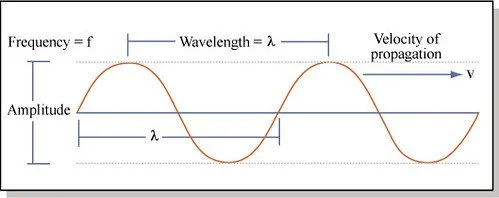In short, wavelength determines the pitch of a sound wave. Sound waves with shorter wavelengths will have a higher pitch and sound waves with longer wavelengths will have a lower pitch.
Now let’s break it all down.
Speed, Wavelength and Frequency
There are all different kinds of waves in the universe. Obviously sound is one example, but light also has characteristics of waves and of course we see waves in water and other liquids as well.
All types of waves share certain characteristics. They can all be described with four qualities: speed, wavelength, frequency and amplitude.

You’ve probably seen a picture before that looks something like this. What does it mean exactly?
Speed
Speed (velocity is essentially the same as speed) is one characteristic of a wave. Sound waves move at the speed of sound (about 343 meters per second). Light waves move at the speed of light. Other waves move at different speeds.
When you sit on the beach, you can actually see the waves coming in to the shore. You could estimate or measure how fast those waves are moving.
But you can’t see sound waves. How might you go about measuring their speed? Have you ever been to a fireworks display? You can see the firework explode before you hear the sound of the explosion.
To measure the speed of sound we just need to make a sound from a distance and then measure how long it takes to reach our ears. For example, if you were to set off a firework at 343 meters away, it would take about 1 second for the sound to reach your ears.
Wavelength
Wavelength is just the distance between two repeating parts of a wave.
Just as ocean waves create high points and low points in the water, sound waves create high pressure points and low pressure points in the air. The distance between two high pressure points would be the wavelength. And the distance between two low pressure points would be the same wavelength.
Frequency
Frequency is the number of times a wave repeats itself in 1 second.
To return to the ocean waves analogy, imagine you are standing with your feet in the water. If you could count how many waves hit your feet over a period of time, that would be a measurement of frequency.
Likewise if you stand in one spot were to measure the number of high pressure points in the air from a sound wave over one second, that would be a measure of frequency.
Amplitude
Amplitude is just a measure of how strong a wave is.
In the ocean, bigger and taller waves have more amplitude. And in sound a higher amplitude means a louder sound.
The Wavelength Formula
Speed, wavelength and frequency are all closely related.
Frequency and wavelength have an inverse relationship, which means when one goes up the other goes down. This makes sense. If you imagine that the distance between two waves gets smaller, then you would expect more waves to pass by you during a period of time.
In fact, the only variable you need to quickly convert between frequency and wavelength is speed. The formula looks like this:
Frequency = Speed / Wavelength
or you can flip around the formula to look like this:
Wavelength = Speed / Frequency
If you already know the frequency of a sound wave you can easily get the wavelength. Usually sound waves are measured in Hertz. Hertz units break down to be “per second” or 1/second.
We know the speed of sound is 343 meters per second.
So dividing 343 meters per second by Hertz (1/second) will give us a wavelength in meters. Here’s a quick example:
343 meters per second / 686 Hertz = 0.5 meters
So a sound wave at 686 Hertz would have a wavelength of 0.5 meters.
Conclusion: So What Does Wavelength Determine in a Sound Wave?
Alright we know all the characteristics of a sound wave. But we don’t know what changes as a sound’s wavelength changes.
Well in order to make that determination we need to add one more variable into the mix: the human ear.
If we ignore the human ear, then wavelength in a sound wave just determines how close together the high and low pressure points are in the air.
But our ears are able to interpret those high and low pressure points as sound. And those sounds are interpreted as pitch.
The notes coming from a tuba are typically between 40 Hertz and 200 Hertz. And the notes coming from a flute are usually between 300 Hertz and 1500 Hertz. And other instruments have different frequency ranges.
Remember our inverse relationship between frequency and wavelength.
A tuba has lower notes at lower frequencies, but a longer wavelength. And a flute has higher notes at higher frequencies, but a shorter wavelength.
So the shorter the wavelength, the high pitched the sound wave is. And the longer the wavelength, the lower pitched the sound wave is.
